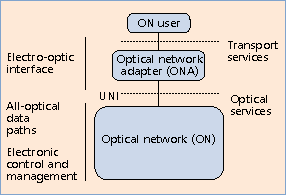| |
Optical Networking
An optical network is a network
where the user-network interface (UNI) is optical and the data does
not undergo optical-to-electrical conversion within the network
(Fig.2). Note that only the data remains optical end-to-end;
signalling, provisioning, and network management services may be
implemented in the ON or over a separate network utilizing the fiber
infrastructure.
- Figure 2 - Service layer
taxonomy
The users/clients of the optical
network (ON) could be
• electronic switching equipment,
such as
• SONET/SDH cross-connects,
• ATM switches,
• IP routers (recall Fig.1); or
• end-user equipment such as
• workstations,
• video servers, and
• so on.
In either of these cases, the ON
user requires an electrical digital circuit, packet, or cell
service. There are also situations where analog transport services
may be preferred (e.g., video distribution in access networks).
The optical network adapter (ONA) is the interface between the
optical network and the ON user. ONAs connect to the optical network
at the UNI and use optical services (described below) to provide
transport services to the ON users. ONAs may be standalone,
connecting to one or more ON users through standard communication
protocols, or integrated within a single ON-user device. The
complexity and cost of an ONA depends strongly on the available
optical services and the desired transport services. Note that in
some situations, the ONA may contain sophisticated optical
technology, such as optical memory, and therefore the UNI is not
necessarily located where the optical signal is converted to
electronics.
|
|




